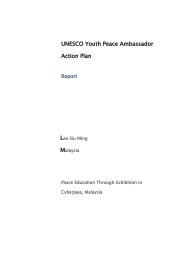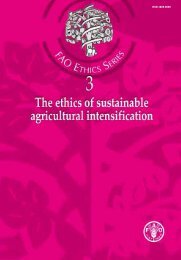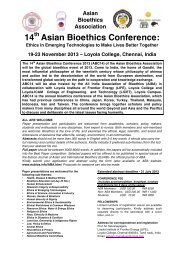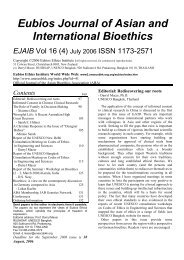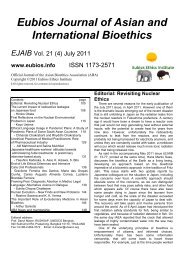Human Dignity, Justice, Fairness, Youth - Eubios Ethics Institute
Human Dignity, Justice, Fairness, Youth - Eubios Ethics Institute
Human Dignity, Justice, Fairness, Youth - Eubios Ethics Institute
You also want an ePaper? Increase the reach of your titles
YUMPU automatically turns print PDFs into web optimized ePapers that Google loves.
44 <br />
Macer, DRJ and Saad-Zoy, S. eds., Asia-Arab Interregional Philosophical Dialogues:<br />
<strong>Human</strong> <strong>Dignity</strong>, <strong>Justice</strong>, <strong>Fairness</strong>, <strong>Youth</strong>, Democracy and Public Policy (UNESCO, 2011)<br />
Unfolding Conceptualization of <strong>Justice</strong> in India<br />
Parag Kadam,<br />
Graduate Diploma in Arts, Department of Anthropology, University of Auckland<br />
Email: paragplk@gmail.com, pkad310@aucklanduni.ac.nz<br />
Every day the streams from the mountains branch out to create new ones, the new streams attach<br />
themselves to other waters which ultimately blossom into something different. They change the<br />
vast oceans every day. We people are a product of our pasts; not just in a personal day to day<br />
manner of behavior, but more so in a social and cultural setting. The history of a region gives it a<br />
flavor. It also makes the people think of where they came from, their heritages and the past ways<br />
of life, thus influencing their present sense of morality. Our oceans are and will always be<br />
invisible and complex. But that’s what makes the bonds between two human beings so beautiful.<br />
For us it is very important to hold onto the roots, studying them not just for mistakes of the past<br />
but for an inspiration to solve today’s problems. In India, the ways of life have changed on a<br />
continuous basis from the ancient period of Hindu predominance with the introduction of<br />
countless foreign powers ranging from Middle East to Western Europe. All of their philosophies<br />
and ways of thinking are incorporated in the making of today’s Indian person. <strong>Justice</strong> is one of<br />
those concepts. Present moral and social justice flash this fact more vehemently than legal justice<br />
which is, for most of the part, a result of its nearest contemporary system in time.<br />
Ancient & Early Medieval India (c. 1700 BC-800 AD)<br />
Ancient Indian concept of justice is very intricate and very contradictory to the modern judicial<br />
ethos. This concept underlines a journey of falling from a perfectly just society and includes the<br />
social codes to follow in the current Kali Yuga, the age of decadence. An individual’s spiritual<br />
enhancement was the aim of society as well as of the state. The system was based upon a very<br />
instinctive and natural philosophy: do good and good will be done to you. This karmic system of<br />
justice entailed an inequality which was again seen to be natural. If one had tried to instigate the<br />
concept of equality it’d been received as very unjust, which is actually true because every person<br />
is different. To explain this, it is necessary to first delve into Indian idea of origin of society and<br />
its different stages: phase of hunter- gatherers, the time when domestication of rice began<br />
leading people not only to develop a proprietary interest but also the concept of family, division<br />
of rice fields as private property followed by its violation and theft and ultimately, the formation<br />
of a new system of justice incorporating the individual, the family and the private property. The<br />
functional division of labor that followed morphed into the birth of Varna system of social<br />
classes. This is explained in details in the Pali text of Agganna Sutta, wherein Buddha, pointing<br />
to Hymn X, 90 of Rigveda, tells this story to the two novices of Buddhist order who are of<br />
Brahmin origin.<br />
The Varna system consisted of four social classes with Khshatriyas, the ones responsible for<br />
protection and order who with a short lived democratic process became the government evolving<br />
into monarchy, Bramhins, the ones devoted for academics and education in general who later<br />
automatically became in charge of all the religious affairs, Vaishyas, the ones responsible for<br />
society’s economy through being agriculturalists, cattle rearers, traders and Shudras, the artisans<br />
and laborers. The exact time of solidification of this system is unknown but first description is<br />
found in the Bramhanical text of Purusha Sutta from Rigveda belonging to the early Vedic period<br />
of 1700-1100 BC. Each class had its share of rights and duties. The social law was a very well




